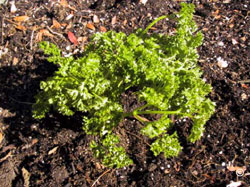Parsley is one of the most widely known culinary herbs and has been in cultivation since the Middle Ages. This plant is native to southern Europe, Algeria and Lebanon. The leaves are high in vitamin C, vitamin A, iron and essential, aromatic oils. Parsley leaves and seeds are generally used in cooking. 
Parsley will generally grow well in a wide variety of soils and sun exposures. Plant parsley seeds in the spring after danger from frost is past. Soak the seeds overnight in water to increase the germination rate indoors or a cold frame about six weeks prior to transplanting outdoors. Sow these seeds about one-fourth of an inch deep and four to six inches apart. Plant the seeds in rows about 12 to18 inches apart when sowing parsley directly into the garden.
Parsley generally requires 70 to 90 days from the time seed is sown to harvest. Seeds may be planted in the fall for an early spring harvest and again in the late winter for an early summer harvest. Avoid planting parsley during excessively hot periods. Plants or seeds may be purchased at local garden centers and nurseries.
Parsley generally overwinters in Colorado, yielding a second crop the following season. This plant is a biennial and will send up flowers the second growing season.
Harvest parsley by bunching the stalks and leaves together and cutting them off with a sharp knife. After washing parsley, place it in a glass of water and refrigerate it until it is needed. To dry parsley, wash and pat it dry, then allow it to air dry completely in a warm, well-ventilated place. Carefully remove the leaves from the stems and store the leaves in an airtight container until you need them.
For more information, see the following Colorado State University Extension fact sheet(s).



